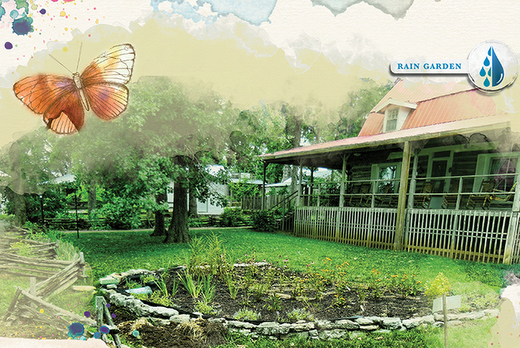A Rain Garden is a landscape depression that can be filled with moisture-loving plants. Hidden beneath the pretty plants is a natural storm water treatment system that allows 30% more water to infiltrate into the ground. This reduces the amount of water from flowing through your property creating erosion or trench areas that you don’t want or going to the city’s stormwater system if your home is in a town.
Rain Gardens are Low Impact Development (LID) approaches to storm water management that are simple to create and maintain. They treat runoff pollution and recharge local groundwater. They improve water quality, protect rivers and streams and can remove standing water.
When properly executed, mosquito breeding is reduced and beneficial insects that eliminate pest insects are increased. A habitat is created for birds, butterflies and other pollinators. Rain Gardens enhance sidewalk appeal and decrease the potential for flooding.
A Rain Garden is designed to collect storm water runoff from impervious surfaces from residential properties such as roof tops, driveways, sidewalks and parking areas. Plants in the garden will trap sediment, fertilizers, oil, grease, pesticides and metals, while roots absorb water and nutrients.
Native vegetation will create deep root systems, withstand dry and wet conditions and create habitat for native pollinators. Decaying roots form tunnels to help water and oxygen filter through soil. Water filters through the soil, replenishing the groundwater supply.
Choose a Location
Locate the garden at the end of a drain spout or roof gutter, at least 10′ downhill from a building, in soil at least 24′ deep and on a slope of less than 12% is the best guideline.
Rain Gardens should not be built over buried utilities or a septic system or under existing trees. Always call 811, a free hotline for locating any underground utilities. They ask that you call 72 hours before you dig, but calling well ahead of time, once you have a rough idea of the location, can save you from having to seriously adjust your design down the road.
Depth
Making sure you are building the right size rain garden is easy to calculate. A Rain Garden should be approximately 4-8′ deep and 5-10% of the size of the surface area that generates storm water runoff. Make sure water table is at least 2’ below soil surface. Some gardens may be much larger or smaller. The exact size and form will depend upon your individual needs.
Slope
Rain gardens should be located in a relatively flat area where the slope is ideally 3-8% but no steeper than 8-10%. Locating a rain garden on a steeper slope will increase the required depth and the amount of labor required to install the rain garden.
Plants
The charm of your Rain Garden will reflect your choices of plants. The hope is that your will select an array of native plants. Native plants will live longer and are more tolerant of local weather and soil conditions. They also attract native birds and butterflies. Your garden center can help you select native plants that will produce curb appeal year-round while doing their jobs in handling your runoff. As with any garden, plant choices will also be guided by how much sunshine the area gets. Traditional annuals or seasonals may be planted above and around the dry margins of the Rain Garden for added interest or accents for transitions.
Getting Started
1. Select a variety of native plant species
2. Buy bark mulch, aged 12 months, non-floating. Sometimes river rock and/or smaller rock gardens may be used. The less mulch and more plants the better.
3. Filter media comprised of
- 25% topsoil
- 50% coarse sand
- 25% shredded bark, wood fiber mulch, peat or other compost
- 3/8 pea stone
- crushed stone
- Some gardens may require perforated pipe to prevent drainage overflow
A percolation test is advised to determine how the site drains:
Dig a hole to 18 inches deep
If it drains less than 24 hours, the site will probably accommodate a rain garden, but will drain quickly and the types of plants needs to be chosen accordingly (“high & dry” plants).
The site is considered to have suitable soils If it takes 24 to 72 hours to drain.
Over 72 hours: Site may not be suitable for rain garden or may require substantial soil amendment.
If water stays ponded in this site most of the year, this is not a good site for a rain garden.
What a Rain Garden is not…
A rain garden will NOT stop flooding
Rain gardens are NOT “water gardens” – designed as water features or to hold water or stay saturated indefinitely. They can be dry much of the year.
Rain gardens are not necessarily “wild.” Native plants are recommended, but other plants can be used. It’s up to you.
This article was contributed by Don Green, a LEED AP biologist who specializes in environmental policy, low impact development, green infrastructure, energy/water nexus, water quality, erosion and sediment control, stormwater and environmental education.
Rain Garden graphics courtesy of beyondthemidway.com.

